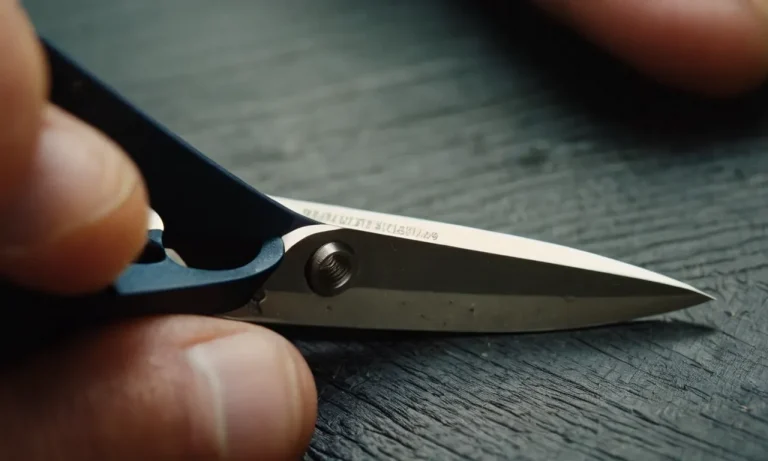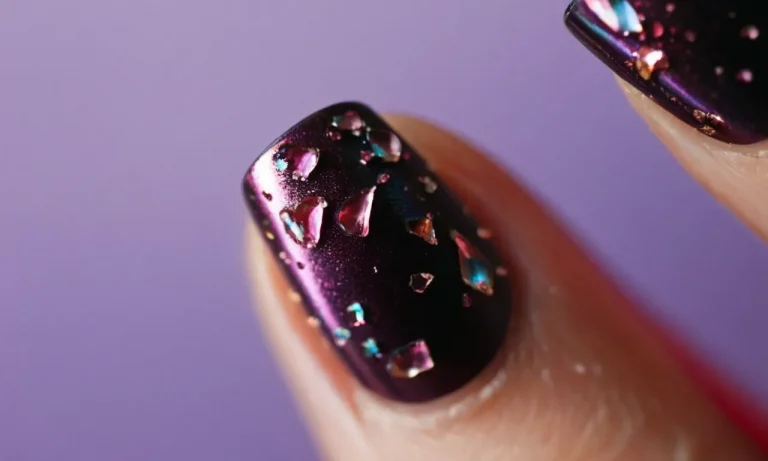What Happens If You Leave Nail Polish On Too Long?
If you’re a nail polish fanatic, you’ve probably wondered at some point – what actually happens if you leave it on for too long? Does it damage your nails? Can it become a health hazard? Here’s a quick answer: Leaving nail polish on for several weeks can lead to discoloration, brittleness, and increased risk of infection in the nail bed.
But removing nail polish promptly and taking good care of your nails will keep them healthy.
In this comprehensive guide, we’ll cover everything you need to know about the effects of leaving nail polish on for extended periods, tips for keeping your nails in good shape, and when you need to see a doctor about nail discoloration or infections.
How Long is Too Long for Nail Polish?
When it comes to nail polish, it’s generally recommended not to go more than 2 weeks without removing and reapplying. Here’s a breakdown of how long different manicure types should last before requiring removal:
2 weeks is the maximum recommended time to keep the same polish
Regular nail polish applied at home typically lasts 5-7 days before starting to chip and peel. Going longer than 2 weeks with the same polish allows more time for bacteria to build up under the polish and increases the risk of nail infections or damage.
According to nail care experts, nail polish should be removed and reapplied every 7-10 days to maintain healthy nails and cuticles. Leaving polish on too long can lead to yellowing, brittle nails, and cracked cuticles.
Salon manicures should be removed after 1 week
Salon manicures often last slightly longer than regular polish, but still should not go beyond 2 weeks. The American Academy of Dermatology recommends getting a salon manicure removed after 1 week.
Salon polish is applied by professionals and layered for maximum durability. However, growth at the nail bed still occurs and can lead to lifting. Going longer than a week allows more opportunities for chips and peeling.
Gel and acrylics should be filled every 2-3 weeks
For gel manicures or acrylic nails, maintenance is crucial. These services polymerize polish or acrylic powder under UV lamps for a long-lasting, chip-resistant finish.
However, as your natural nails grow, the gap between the polish and cuticle becomes larger. Most manicurists recommend getting gel or acrylic nails filled every 2-3 weeks to prevent lifting and avoid potential damage when the polish is eventually removed.
Neglecting to get timely fill-ins can lead to cracked nails and infections in the separated areas. Any serious issues may require removing the gels or acrylics entirely and allowing the natural nail to recover.
No matter what type of manicure you get, be sure to keep up with professional maintenance appointments. Allowing polish to go beyond 2 weeks increases the chances of damage to your natural nails that can be difficult to reverse.
What Happens if you Leave Nail Polish on Too Long?
Can lead to discoloration, staining, and brittleness
Leaving nail polish on for too long can cause the nails to become stained and discolored. The nails may start to yellow or become darker in color the longer the polish is left on. This discoloration can be difficult to remove even with nail polish remover.
The staining occurs because the nail polish seeps into the nails over time.
In addition, keeping the same polish on for weeks or months may cause the nails to become dry and brittle. The solvents in nail polish can break down the oils in the nails that keep them flexible. Brittle nails are more prone to cracking, peeling, and breaking.
Increased risk of fungal and bacterial infections
When you leave nail polish on for extended periods, it can trap moisture against the nails and cuticles. This warm, moist environment encourages the growth of fungi and bacteria. Fungal infections like onychomycosis can cause the nail to thicken, distort, and become discolored.
Bacterial infections may result in redness, swelling, and pus around the nails.
Experts recommend changing your nail polish every 4-7 days to allow the nails to “breathe” and decrease infection risk. The longer old polish is left on, the higher the likelihood of developing nail infections.
Polish can thicken and become gummy over time
Nail polish is formulated to stay on for about a week before needing to be changed. As the week goes on, the polish can begin to thicken and become gummy or glue-like. This is because the solvents in the polish start evaporating over time. With prolonged wear, the polish may feel sticky on the nails.
Thick, gummy polish is hard to remove. You’ll end up working much harder to take it off. So it’s best to remove nail polish while it’s still relatively smooth.
Can damage the nail bed and cuticles
When you pick off old nail polish, you risk damaging the nail bed and cuticles. Constant picking and peeling causes irritation to the delicate skin around the nails. It can result in redness, swelling, hangnails, and even bleeding in severe cases.
Picking off polish also removes layers of the nail bed itself. This can thin and weaken nails over time, making them peel and split more readily. For healthy nails, experts recommend using a non-acetone polish remover weekly instead of picking.
Tips for Healthy Nails
Use nail polish remover regularly
It’s tempting to just paint over chipped polish, but allowing polish to build up can lead to brittle, discolored nails over time. Use acetone-free remover to take off old polish every 1-2 weeks so you’re starting with a clean slate. This prevents staining and allows nails to breathe.
Moisturize nails and cuticles
Dry, brittle nails can split and peel. Massaging cuticle oil into nails and cuticles 1-2 times per day nourishes the nail bed for stronger growth. Look for oils with vitamin E or jojoba which penetrate deeply. You can also apply a thick hand cream after washing hands to lock in moisture.
Avoid picking at your nails
As tempting as it is, avoid biting nails or tearing and picking at hangnails. This can damage the nail bed and lead to infections. Instead, clip hangnails carefully after softening them in warm water. For oral fixation, try chewing gum or keeping nails neatly trimmed and polished to discourage biting.
Try vitamins and supplements for stronger nails
Like hair and skin, nails can benefit from nutrients that support growth and strength. Biotin, vitamin C, calcium and folic acid have been linked to healthier nails. A balanced diet should provide many of these, but supplements are another safe option.
One study found 2500 mcg of biotin per day improved nail thickness by 25% 🤯
Use a base coat under polish
A good base coat creates a smooth surface for polish adherence and prevents staining of the nails. It also adds a protective barrier against damage. Opt for a nourishing base coat formula containing strengthening ingredients like calcium, vitamin E and essential oils.
This helps build strong, flexible nails that resist splitting and breaking.
When to See a Doctor
If nails become discolored, thickened or brittle
If you notice your nails becoming discolored, thickened, or brittle after leaving nail polish on for too long, it’s a good idea to make an appointment with your doctor or dermatologist. Darkening, thickening, or brittleness can indicate an underlying health condition or fungal infection that needs treatment.
For example, yellow, brown, or gray discoloration with nail thickening may signal a fungal nail infection. Brittle nails that split or break easily may result from thyroid conditions, skin disorders, or nutritional deficiencies.
Your doctor can run tests and determine the cause and best treatment options.
Foul odor coming from nails
A foul, unpleasant odor emanating from underneath the nails is not normal. A bad smell is often the first noticeable sign of nail fungus or early stage nail infection. The sooner treatment begins, the better chance of clearing the infection before lasting damage occurs.
See your doctor right away if you detect a foul nail odor, especially if accompanied by nail discoloration, thickening, brittleness or loosening. Prescription oral and topical anti-fungal medications from your doctor work better than over-the-counter treatments for moderate to severe cases.
Separation of the nail from bed
It’s important to promptly contact your doctor at the first signs of nail lifting or separation of the nail plate from the nail bed underneath. As the gap widens, risk increases for infection, permanent nail damage, and discomfort.
In mild cases of separation, an adhesive may reattach the nail. More advanced cases require removal of part or all of the nail to allow healing and prevent progression of infection deeper into the nail bed tissue.
Redness, swelling or pus around nails
Redness, swelling, throbbing, pus and tenderness around the nail are classic signs of a nail infection or abscess that has advanced deeper below the nail plate into the sensitive nail bed. This allows bacteria to enter and is quite painful.
See your doctor right away if you notice these worrisome symptoms, which indicate a nail infection requires medical treatment. Antibiotics, draining an abscess, or partial nail removal may be necessary. Delaying treatment can cause the infection to spread and result in nail deformity or loss.
Persistent nail infections
If over-the-counter topical treatments don’t resolve your nail fungal or bacterial infection, see your doctor. Persistent infections lasting more than 6 months have likely progressed deeper into the nail bed tissue.
Oral prescription medications from your doctor work better than creams for difficult-to-treat nail infections. Seeking timely medical care also prevents the infection from permanently damaging nails and avoids the risk of it spreading to other fingers and toes.
Conclusion
While an occasional extra week with the same nail polish won’t do major damage, keeping it on for extended periods can increase your risk for nail infections, discoloration and brittleness. Get into the habit of removing old polish and caring for your nails regularly.
See a doctor if you notice signs of a fungal or bacterial infection. With proper nail care habits, you can keep your natural nails healthy, beautiful and ready for your next fabulous manicure!







